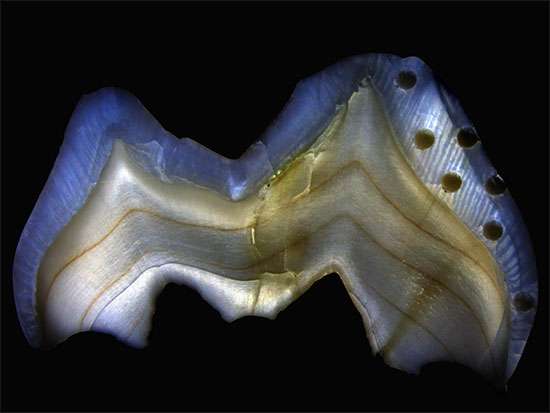June 9, 2017 report
Researchers find biomarker in deciduous teeth for establishing the age of weaning

(Phys.org)—The transition from breastfeeding to a nonmilk diet is a developmental milestone, influencing future health and survival of mammals, including humans. Breast milk is highly beneficial to infants, conferring easily digested nutrients and energy, while also strongly enhancing young immune systems. However, as infants grow, their metabolic needs outstrip the resources that mothers can provide, and the transition to nonmilk food becomes necessary.
But this transition has risks, as weaning exposes offspring to exogenous pathogens and the possibility of food shortages. So the timing of the transition is key, balancing the heightened metabolic and energy needs of a growing infant as well as the recovery of the maternal reproductive ability. Unlike many great apes, human infants are fully weaned before independent feeding, which has profound implications for life trajectory: The later age of first female reproduction, shorter intervals between births, and a longer lifespan after menopause are all strongly influenced by the age and rapidity of weaning.
Thus, establishing the age of weaning is important in anthropology and biology. The study of ancestral humans is inhibited by the lack of known biomarkers establishing when infants achieve this developmental milestone, and researchers have theorized that variations in the chemical and isotopic composition of the enamel, bone or the dentine of teeth could reveal key information, including the age of weaning.
Recently, a group of French researchers conducted a study of the teeth of modern humans to determine if such a biomarker exists. Calcium stable isotope ratios in the teeth confer information about milk consumption, and the study determined that human tooth enamel records a temporal variation in these isotopes—one that could eventually allow reconstruction of the weaning practices of ancestral humans.
The calcium isotope ratios of breast milk are significantly lower than those associated with dietary intake, and the researchers expected that after weaning, there would be a positive shift in those ratios recorded in teeth. Previous studies of calcium isotope ratios were unable to distinguish between those from animal milk and breast milk; in the current study, the researchers focused on δ44/42Ca in the deciduous teeth of a group of modern humans whose weaning ages were known. They collected 150 samples from 51 deciduous teeth of 12 individuals who were categorized into three groups: those exclusively breastfed from birth; those exclusively fed packaged formula from birth; and those initially breastfed before a transition to formula.
The researchers found the drift in calcium isotope uptake is directly related to the duration of breastfeeding. They cite a number of reasons for the low levels of calcium isotopes in breastmilk, including the fact that lactation induces increased mobilization of light skeletal calcium, which could cause a decrease in the mother's blood levels of δ44/42Ca.
The researchers write, "The present approach allows distinguishing weaning practices in modern humans as recorded in deciduous tooth enamel. In this case, it allows distinguishing a cessation of suckling occurring within the first year, representative of weaning practices in Europe, from a behavior resembling early weaning of nonindustrialized modern humans, occurring between two and three years old."
More information: Assessing human weaning practices with calcium isotopes in tooth enamel. PNAS 2017, May 30, 2017, DOI: 10.1073/pnas.1704412114
Abstract
Weaning practices differ among great apes and likely diverged during the course of human evolution, but behavioral inference from the fossil record is hampered by a lack of unambiguous biomarkers. Here, we show that early-life dietary transitions are recorded in human deciduous tooth enamel as marked variations in Ca isotope ratios (δ44/42Ca). Using a sequential microsampling method along the enamel growth axis, we collected more than 150 enamel microsamples from 51 deciduous teeth of 12 different modern human individuals of known dietary histories, as well as nine enamel samples from permanent third molars. We measured and reconstructed the evolution of 44Ca/42Ca ratios in enamel from in utero development to first months of postnatal development. We show that the observed variations of δ44/42Ca record a transition from placental nutrition to an adult-like diet and that Ca isotopes reflect the duration of the breastfeeding period experienced by each infant. Typically, the δ44/42Ca values of individuals briefly or not breastfed show a systematic increase during the first 5–10 mo, whereas individuals with long breastfeeding histories display no measurable variation in δ44/42Ca of enamel formed during this time. The use of Ca isotope analysis in tooth enamel allows microsampling and offers an independent approach to tackle challenging questions related to past population dynamics and evolution of weaning practices in hominins.
Journal information: Proceedings of the National Academy of Sciences
© 2017 Phys.org




















